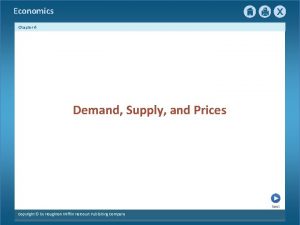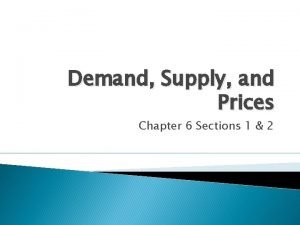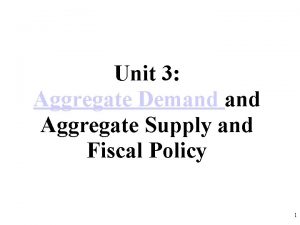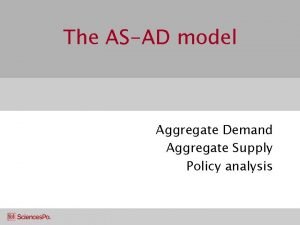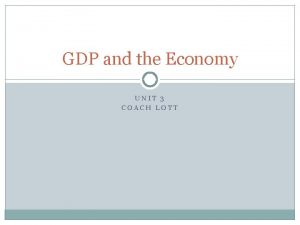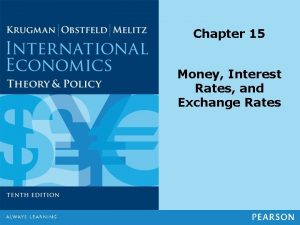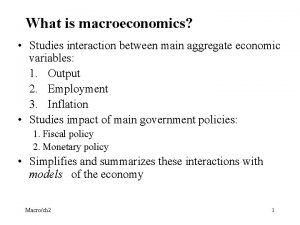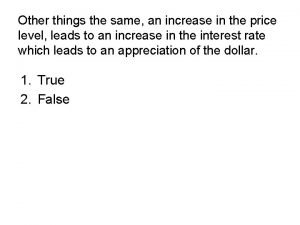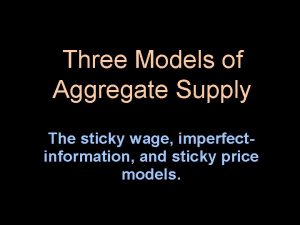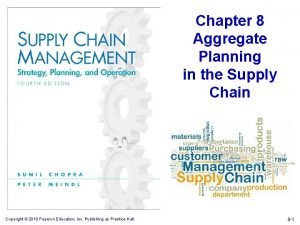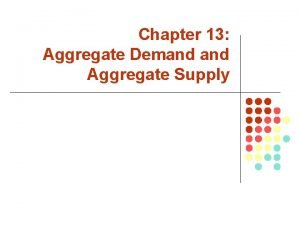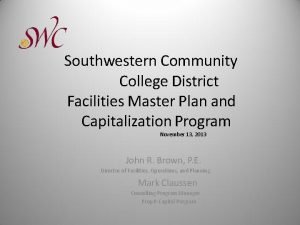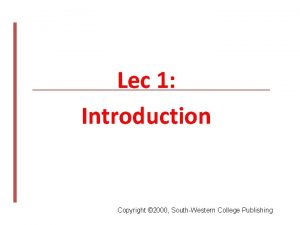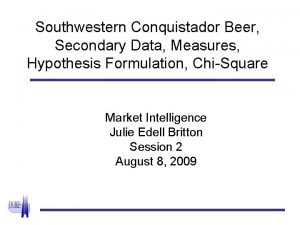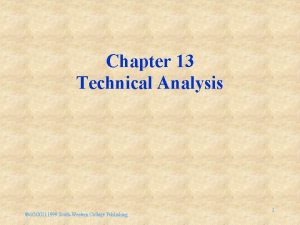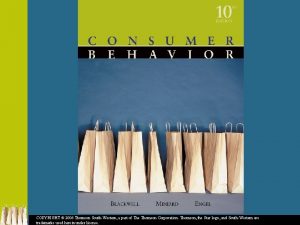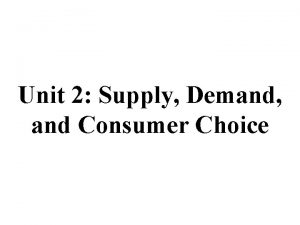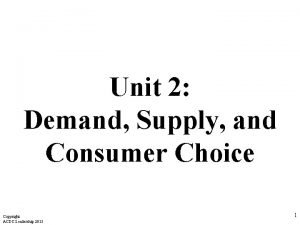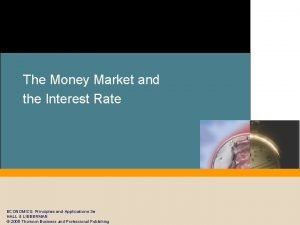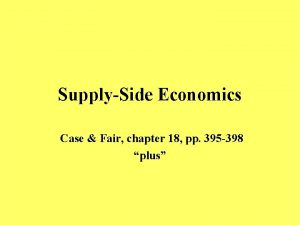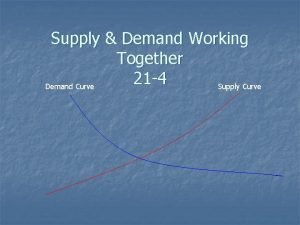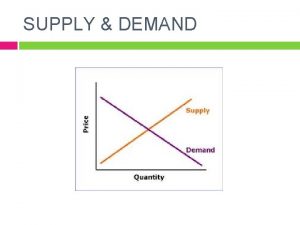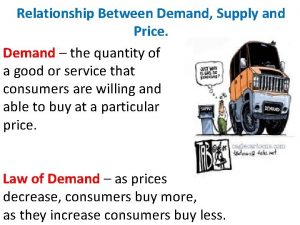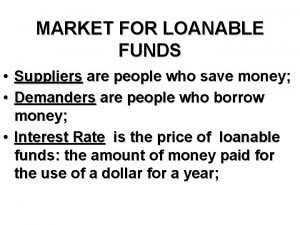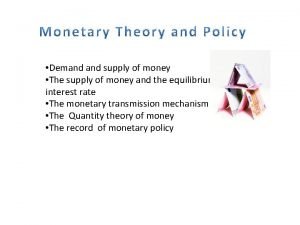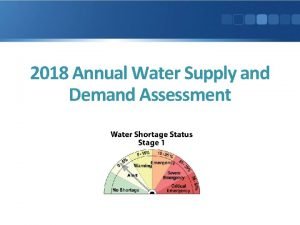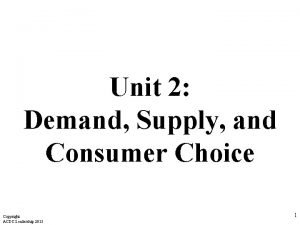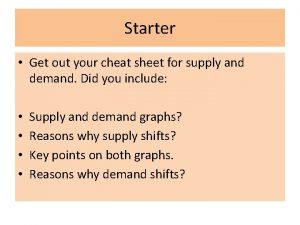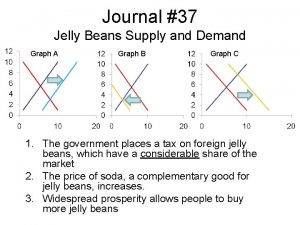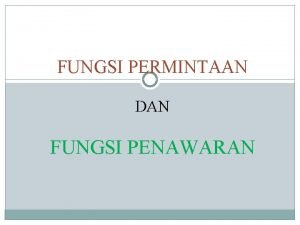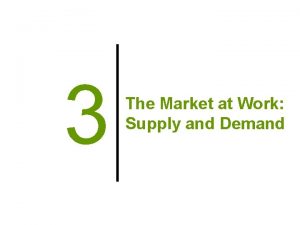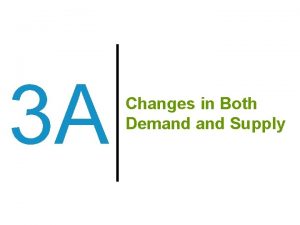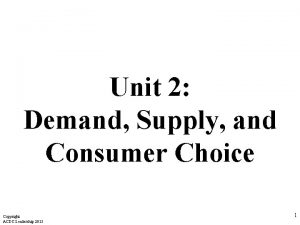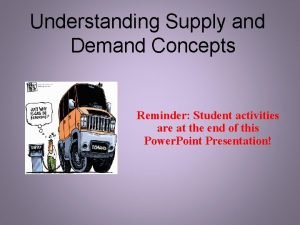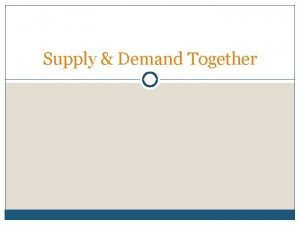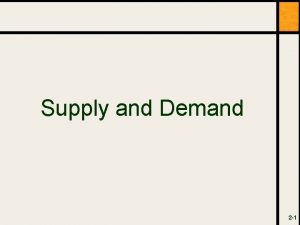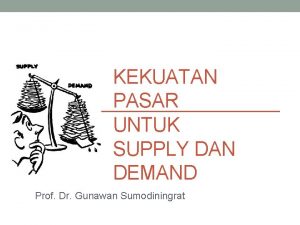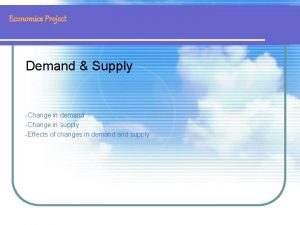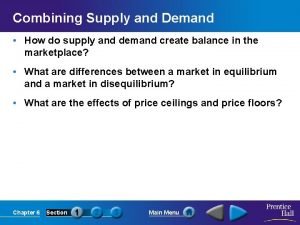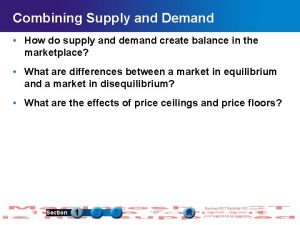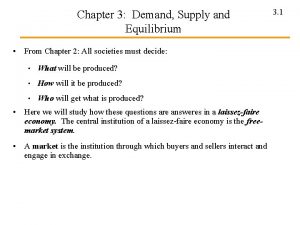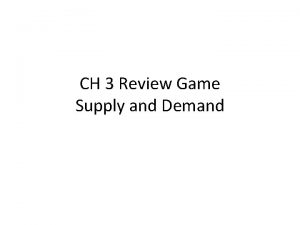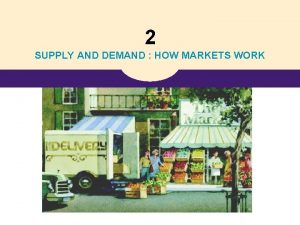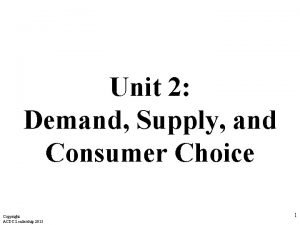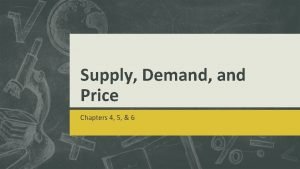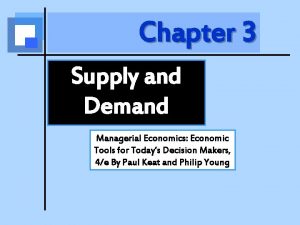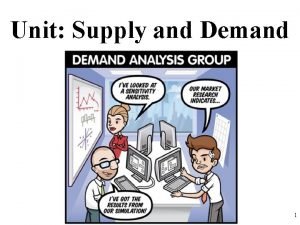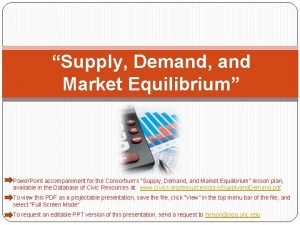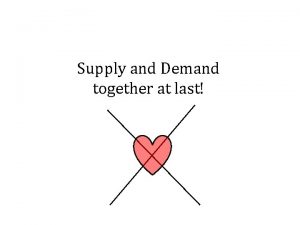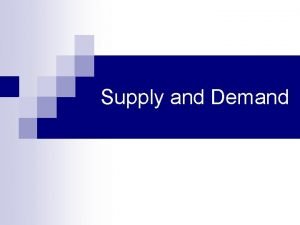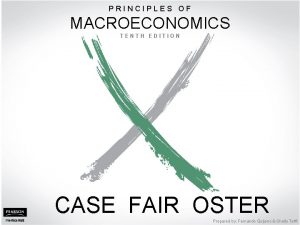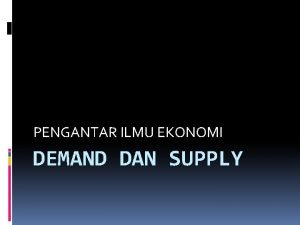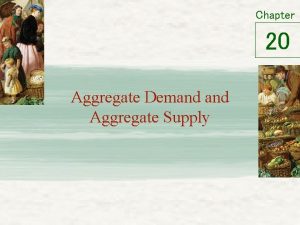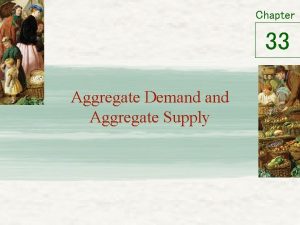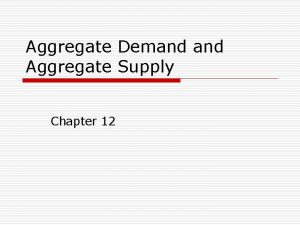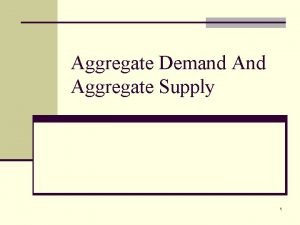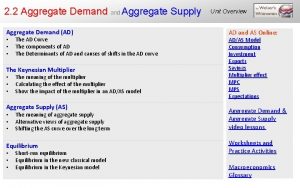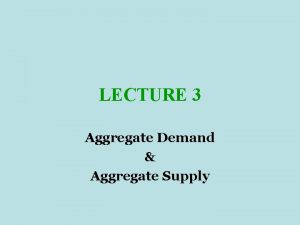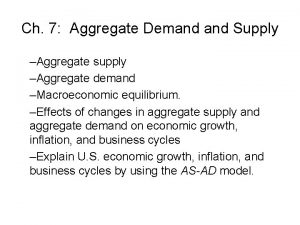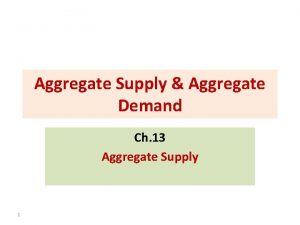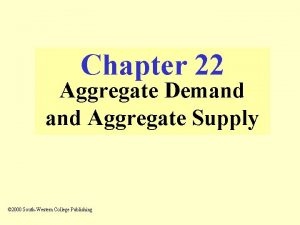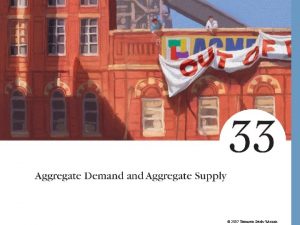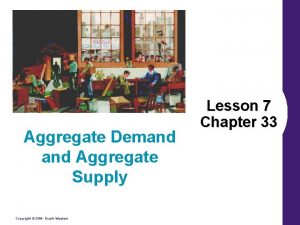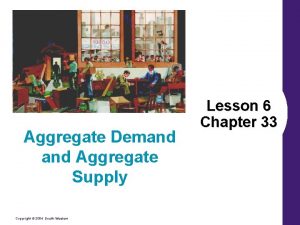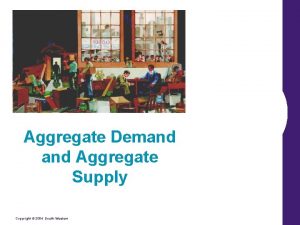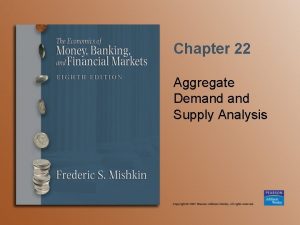Chapter 4 Aggregate Demand Aggregate Supply 2002 SouthWestern



















































































































- Slides: 115

Chapter 4 Aggregate Demand Aggregate Supply © 2002 South-Western

Economic Topics • The phases of the business cycle • Gross Domestic Product (GDP) • The CPI and GDP deflator • Nominal and real GDP • Aggregate demand aggregate supply • Macroeconomic equilibrium • Demand-pull and supply-push inflation 2

Recession and Prosperity Recession A phase in the business cycle in which the decline in the economy’s real GDP persists for at least a half-year. A recession is marked by relatively high unemployment. 3

Recession and Prosperity Depression Severe recession. 4

Recession and Prosperity A phase in the business cycle marked by a relatively high level of real GDP, full employment, and inflation. 5

Recession and Prosperity Inflation An increase in the price level. 6

Recession and Prosperity Business cycle Alternating periods of growth and decline in an economy’s GDP. 7

Recession and Prosperity Business cycle No two business cycles are identical. The number of months in any given phase of the cycle varies from cycle to cycle. 8

Recession and Prosperity Trough The bottom of a business cycle. 9

Why Recession? Why Prosperity? Trough This is the time period when the economy’s unemployment rate is greatest and output declines to the cycle’s minimum level. 10

Why Recession? Why Prosperity? Recovery A phase in the business cycle, following a recession, in which real GDP increases and unemployment declines. 11

Recession and Prosperity Peak The top of a business cycle. 12

Recession and Prosperity Peak This is the time period when output reaches its maximum level, the labor force is fully employed, and increasing pressure on prices is likely to generate inflation. 13

Recession and Prosperity Downturn A phase in the business cycle in which real GDP declines, inflation moderates, and unemployment emerges. 14

Recession and Prosperity Trend lines trace the economy’s output performance over the course of a business cycle, measured either from recession to recession or from prosperity to prosperity. 15

Recession and Prosperity • Upward-sloping trend lines signify economic growth. • The steeper the trend line, the higher the economy’s rate of growth. • When no growth occurs, the trend line is horizontal. 16

EXHIBIT 1 THE BUSINESS CYCLE 17

Exhibit 1: The Business Cycle What does the trend line in Exhibit 1 tell us about the economy’s output performance? • The trend line shows that the economy is growing. 18

Macroeconomics tries to answer…. . n n n What causes the economy to grow? Or shrink? What factors contribute to the increase in the production of goods and services cycle after cycle? And others regarding the business cycle. 19

Measuring the National Economy Gross Domestic Product (GDP) Total value of all final goods and services, measured in current market prices, produced in the economy during a year. 20

Measuring the National Economy Gross Domestic Product (GDP) “Final goods and services” refers to everything produced that is not itself used to produce other goods and services. - Would count peanut butter if sold on the shelf at the store; however would not count it if sold to a baker to make peanut butter pie 21

Measuring the National Economy Gross Domestic Product (GDP) “During a given year” refers to a specific calendar year. - January 1 through December 31 22

Measuring the National Economy Gross Domestic Product (GDP) “Produced in the economy” refers to any good or service produced in the United States, regardless of whether a US-owned or a foreignowned company produced the good. 23

Measuring the National Economy Gross Domestic Product (GDP) Conversely, goods produced by US -owned firms in foreign countries are not included in GDP. 24

Measuring the National Economy To compare GDP across years, we must devise some way of eliminating the effect of inflation. 25

Measuring the National Economy Nominal GDP measured in terms of current market prices -- that is, the price level at the time of measurement. (It is not adjusted for inflation. ) 26

Measuring the National Economy Real GDP adjusted for changes in the price level. 27

Measuring the National Economy • Price indices are designed to remove the effect of price changes. • The consumer price index and the GDP deflator are the two indices most commonly used. 28

Measuring the National Economy Consumer Price Index (CPI) A measure comparing the prices of consumer goods and services that a household typically purchases to the prices of those goods and services purchased in a base year (“market basket of goods”). 29

Measuring the National Economy Base year The reference year with which prices in other years are compared in a price index. 30

Measuring the National Economy Price level A measure of prices in one year expressed in relation to prices in a base year. 31

Measuring the National Economy Example: Suppose in 1998 (the base year) a basket of goods including such things as food, clothing, and fuel cost $350. The $350 converts to a price level index of 100, P=100. 32

Measuring the National Economy Example: Suppose in the next year, 1999, the same basket of goods cost $385. The 1999 CPI, measured against the 1998 base year of 100, is 110. P=($385/$350)*100=110. 33

Measuring the National Economy Example: A 1999 P=110 indicates that from 1998 to 1999 the cost of goods and services that consumers typically buy increased by 10 percent. 34

Usefulness of the base year n The usefulness of the base year diminishes the further you get from it q q New products are on the market every year Consumer basket changes then year to year 35

Measuring the National Economy GDP deflator A measure comparing the prices of all goods and services produced in the economy during a given year to the prices of those goods and services purchased in a base year. 36

Measuring the National Economy GDP deflator This price index includes not only consumer goods and services, but also producer goods, investment goods, exports and imports, and goods and services purchased by government. 37

Measuring the National Economy GDP deflator This price index is used to convert nominal GDP to real GDP. 38

Measuring the National Economy The formula to convert from nominal GDP to real GDP is: Real GDP = (nominal GDP*100)/ GDP deflator. 39

EXHIBIT 2 CONVERTING NOMINAL GDP TO REAL GDP: 1995– 2000 ($ BILLIONS, 1996 = 100) Source: U. S. Department of Commerce, Bureau of Economic Analysis. 40

Exhibit 2: Converting Nominal GDP to Real GDP: 1995 -2000 1. What is the nominal difference between GDP in 1996 and 1997? • The nominal difference = $8, 318. 4 billion $7, 813. 2 billion = $505. 2 billion. 41

Exhibit 2: Converting Nominal GDP to Real GDP: 1995 -2000 2. What is the real difference between GDP in 1996 and 1997? • Real GDP in 1996 is = ($7, 813. 2 billion*100)/100. 00=$7, 813. 2 billion. 42

Exhibit 2: Converting Nominal GDP to Real GDP: 1995 -2000 2. What is the real difference between GDP in 1996 and 1997? • Real GDP in 1997 = ($8, 318. 4 billion*100)/101. 95=$8, 159. 5 billion. 43

Exhibit 2: Converting Nominal GDP to Real GDP: 1995 -2000 2. What is the real difference between GDP in 1996 and 1997? • The real difference = $8, 159. 5 billion $7, 813. 2 billion = $346. 3 billion. 44

Deriving Equilibrium GDP in the Aggregate Demand Supply Model The aggregate demand aggregate supply model is one model used to explain how GDP is determined. 45

Deriving Equilibrium GDP in the Aggregate Demand Supply Model Aggregate supply The total quantity of goods and services that firms in the economy are willing to supply at varying price levels. 46

Deriving Equilibrium GDP in the Aggregate Demand Supply Model There are three distinct segments of the aggregate supply curve: 1. Horizontal segment. Real GDP increases without affecting the economy’s price level. 47

Deriving Equilibrium GDP in the Aggregate Demand Supply Model There are three distinct segments of the aggregate supply curve: 2. Upward-sloping segment. A positive relationship between real GDP and price level. 48

Deriving Equilibrium GDP in the Aggregate Demand Supply Model There are three distinct segments of the aggregate supply curve: 3. Vertical segment. All resources are fully employed, so that real GDP cannot increase. 49

Deriving Equilibrium GDP in the Aggregate Demand Supply Model Aggregate demand The total quantity of goods and services demanded by households, firms, foreigners, and government at varying price levels. 50

Deriving Equilibrium GDP in the Aggregate Demand Supply Model Increases in the price level affect people’s real wealth, their lending and borrowing activity, and the nation’s trade with other nations. 51

Deriving Equilibrium GDP in the Aggregate Demand Supply Model The quantity of goods and services demanded in the economy declines when price levels increase. 52

EXHIBIT 3 AGGREGATE SUPPLY AND AGGREGATE DEMAND 53

Exhibit 3: Aggregate Supply and Aggregate Demand At what real GDP value is fullemployment of resources realized in Exhibit 3? • Full-employment real GDP is $9. 5 trillion. 54

Deriving Equilibrium GDP in the Aggregate Demand Supply Model • The aggregate demand curve shifts when there is a change in the quantity of goods and services demanded at a particular price level. • Government spending, income levels, and expectations about the future all factors that can cause the curve to shift. 55

Deriving Equilibrium GDP in the Aggregate Demand Supply Model The aggregate supply curve shifts due to factors such as changes in resource availability and resource prices. 56

EXHIBIT 4 SHIFTS IN AGGREGATE DEMAND AGGREGATE SUPPLY 57

Exhibit 4: Shifts in Aggregate Demand Aggregate Supply What might cause the aggregate demand curve in panel a of Exhibit 4 to shift to the right? • Increases in government spending, increases in incomes, and optimistic expectations could all cause the aggregate demand curve to shift to the right. 58

Macroeconomic Equilibrium Macroequilibrium The level of real GDP and the price level that equate the aggregate quantity demanded and the aggregate quantity supplied. 59

EXHIBIT 5 ACHIEVING MACROECONOMIC EQUILIBRIUM 60

Exhibit 5: Achieving Macroeconomic Equilibrium 1. At what price level and real GDP is macroequilibrium achieved in Exhibit 5? • Macroequilibrium is achieved at P = 101. 95 and real GDP = $8. 1595 trillion. 61

Exhibit 5: Achieving Macroeconomic Equilibrium 2. What happens when the price level increases to P=110? • At P=110, the aggregate quantity demanded falls to $5 trillion and the aggregate quantity supplied increases to $9 trillion. 62

Equilibrium, Inflation, and Unemployment • The Depression of the 1930 s produced one of the poorest GDP performance records in our economic history. • Real GDP fell by 30 percent in the first four years of the decade. 63

Equilibrium, Inflation, and Unemployment The US commitment to support England during World War II changed the pace and direction of our national economy significantly. 64

Equilibrium, Inflation, and Unemployment • Government war-related spending shifted the aggregate demand curve to the right. • With millions of men and women joining the armed forces, the size of the civilian labor pool declined and the aggregate supply curve shifted to the left. 65

Equilibrium, Inflation, and Unemployment • The same basic shifts in aggregate demand supply occurred during the Vietnam War. • Unlike the poor economic condition prior to WWII, however, the economy was already relatively vigorous prior to the Vietnam war. Inflation resulted. 66

Equilibrium, Inflation, and Unemployment Demand-pull inflation Inflation caused primarily by an increase in aggregate demand. 67

Equilibrium, Inflation, and Unemployment Stagflation A period of stagnating real GDP, rapid inflation, and relatively high levels of unemployment. 68

Equilibrium, Inflation, and Unemployment The oil price increases imposed by OPEC during the 1970 s caused the cost of producing nearly everything in the economy to increase. The aggregate supply curve shifted to the left. GDP declined while the price level increased. 69

Equilibrium, Inflation, and Unemployment Cost-push inflation Inflation caused primarily by a decrease in aggregate supply. 70

EXHIBIT 6 AGGREGATE DEMAND AGGREGATE SUPPLY DURING THE DEPRESSION AND WAR PERIOD AND THE OIL PRICE INCREASES 71

Exhibit 6: Aggregate Demand Aggregate Supply During the Depression and War Period and the Oil Pricedoes Increases How macroeconomic equilibrium change before and after OPEC in panel b of Exhibit 6? • The aggregate supply curve shifts to the left after OPEC. 72

Exhibit 6: Aggregate Demand Aggregate Supply During the Depression and War Period and the Oil Price Increases How does macroeconomic equilibrium change before and after OPEC in panel b of Exhibit 6? • A new equilibrium is obtained at a lower level of real GDP and at a higher price level. 73

Equilibrium, Inflation, and Unemployment • During the second half of the 1980 s, the economy was performing about as well as it ever had in the last quarter century. • Tax reforms, ready credit, leveraged buyouts, a commercial real estate boom, and optimistic expectations contributed to the already strong aggregate demand. 74

Equilibrium, Inflation, and Unemployment Leveraged buyout A primarily debt-financed purchase of all the stock or assets of a company. 75

Equilibrium, Inflation, and Unemployment The recession of 1990 -91 was caused by an inward shift in aggregate demand. Reduced federal revenue sharing with states, downsized government budgets, cuts in demand for military goods, and high levels of debt acquired during the 1980 s are all to blame. 76

Can We Avoid Unemployment and Inflation? Although the desired macroequilibrium outcome would occur at a real GDP level consistent with full employment and no inflation, this level is not always achieved. 77

Can We Avoid Unemployment and Inflation? Some economists believe government should act in ways to help shift macroequilibrium to this position. 78

Can We Avoid Unemployment and Inflation? Increasing or decreasing government spending and income taxes are two methods government can use to attempt to shift the aggregate demand curve. 79

EXHIBIT 7 OBTAINING FULL-EMPLOYMENT GDP WITHOUT INFLATION 80

Exhibit 7: Obtaining Full. Employment GDP Without Inflation How might government shift the aggregate demand curve from AD to AD’ in Exhibit 7? • Government could increase spending and reduce income taxes in order to shift the demand curve to the right. 81

Question What is macroeconomics? 82

Answer Macroeconomics is a discipline within economics that studies the behavior of the economy as a whole. It describes and explains the derivation of total output and income, the price level, aggregate employment, and other broad measures of overall economy activity. 83

Question Describe the phases of the business cycle. 84

Answer The typical business cycle has four phases: recession, recovery, prosperity, and downturn. In the recession phase, the unemployment rate is relatively high and rising while the rate of output growth is relatively low and declining (sometimes to zero or it may even become negative). In the recovery phase, the rate of output growth increases along with the price level while the unemployment rate decreases. In prosperity, the economy’s output reaches its maximum, resources are fully employed, and upward pressure on prices generates inflation. Eventually, prosperity weakens and is followed by a downturn phase in which the rate of output growth falls again, the rate of unemployment rises, and inflation moderates. Cycles are like a roller-coaster ride in the sense that both involve repeated up-and-down motion. In the business cycle, however, the motion occurs around an overall upward trend. 85

Question How do economists measure an economy’s performance? 86

Answer Macroeconomic performance is most commonly measured by gross domestic product (GDP), which is the value of all goods and services produced in the economy during a given year, calculated at current market prices. As GDP rises, so does employment, so GDP is both a measure of an economy’s output and its ability to provide jobs. 87

Question What is the difference between nominal and real GDP? 88

Answer Nominal GDP is measured in current dollars. It may increase from one year to the next because more output is produced, because prices rise, or both. Real GDP is nominal GDP adjusted for changes in the economy’s price level. In comparing real GDPs from one year to the next, the quantities of goods and services may change, but the prices they are valued at remain unchanged 89

Question What is the consumer price index? How is it constructed? Why does the index become increasingly unreliable over time? 90

Answer A consumer price index (CPI) compares the prices of a fixed basket of goods and services purchased by a typical household in a particular year to the prices of that same basket in a base year. Over time, this fixed basket becomes increasingly unreliable as a measure of the economy’s CPI because it fails to recognize that households change their purchasing patterns, that the quality of goods change, and that new goods appear on the market that are not represented in the basket so that the basket becomes less and less representative of the items a typical household buys. 91

Question What is the difference between a consumer price index and GDP deflator? 92

Answer A consumer price index measures the prices of a fixed basket of consumer goods and services over time. A GDP deflator measures the prices of all goods and services produced in the economy over time. 93

Question Which price index is generally uses to transform nominal GDP and real GDP? 94

Answer The GDP deflator converts nominal to real GDP. The conversion equation is: real GDP = (nominal GDP / GDP deflator) × 100. 95

Question What is aggregate demand? Draw an aggregate demand curve and explain its shape? What factors influence aggregate demand? 96

Answer Aggregate demand (AD) is the total quantity of goods and services demanded by households, firms, foreigners, and government at various price levels. The AD curve is downward sloping, showing that as the price level increases, less real GDP is demanded. The shape of the AD curve reflects three kinds of influences. First, as the price level increases, the value of an individual’s real wealth—in the form of cash, bank deposits, and government bonds—falls. To replenish their wealth, households tend to save more and therefore consume less. By so doing, their demand for real GDP falls. Second, as the price level increases, people discover that they need more money to buy the same quantity of goods. Many resort to borrowing. As they do so, they drive up the interest rate. The higher interest rate, in turn, dampens aggregate demand, especially the investment demands made by firms. Finally, if the domestic price level increases while foreign price levels remain unchanged, foreign demand for domestic goods falls, while domestic households switch from demanding domestic goods to the cheaper foreign goods. 97

Answer 98

Question What is aggregate supply? Draw an aggregate supply curve and explain its shape. What factors influence aggregate supply? 99

Answer Aggregate supply (AS) is the total quantity of goods and services that firms in the economy are willing to supply at various price levels. The AS curve has three segments: horizontal, upward sloping, and vertical. Because employment and GDP are directly related—rising GDP means more jobs, falling GDP means fewer jobs—at low GDP levels, unemployment is relatively high so that firms can hire workers without having to increase the wage rate. Along the GDP range from 0 to 10, this situation occurs, producing the horizontal aggregate supply curve. However, at GDP levels greater than 10, more labor and other resources are employed so that firms must resort to paying higher wages and other production costs. These increases in the costs of production raise the price level. Thus, there is a direct relationship between the level of GDP and the price level. This is shown in the upward-sloping segment of the AS curve. Finally, when all resources are fully employed, at GDP = 20, aggregate supply reaches an impassable limit. No matter how high the price level rises, no more output can be produced. The AS curve becomes vertical. 100

Answer 101

Question What does macroequilibrium mean? 102

Answer Macroequilibrium means that the economy has gravitated toward and reached a price level and level of GDP which is stable. Any displacement from these levels will create forces to drive the economy back to these levels. In macroequilibrium, aggregate quantity of GDP demanded equals the aggregate quantity of GDP supplied. Graphically, this occurs at a point where the AD and AS curves intersect. 103

Question Draw a diagram illustrating macroequilibrium at less than full employment. 104

Answer 105

Question What is demand-pull inflation? Draw a diagram illustrating such an inflation. Give an example. 106

Answer In demand-pull inflation, rightward shifts of the AD curve along the upward-sloping and vertical segments of the AS curve lead to higher price levels. It is called demand-pull because it is the change in aggregate demand that creates the increase in the price level. An example of demand-pull inflation is the inflation associated with the Vietnam War. Beginning from a period of near-full employment in the mid-1960 s, the increased government defense spending occasioned by the war pressed real GDP to its limit and forced the price level upward. 107

Answer 108

Question What is cost-push inflation? What might cause it? 109

Answer A cost-push inflation is one caused primarily by a decrease in aggregate supply. Anything that drives up the cost of basic goods shifts the AS curve to the left, creating macroequilibrium at a higher price level. For example, the higher oil prices that resulted from a predominantly OPEC-controlled oil market had just that effect. Aggregate supply decreased and cost-push inflation resulted. 110

Question What can the government do to change macroeconomic equilibrium? 111

Answer Increases in government spending and decreases in taxes shift the AD curve to the right. In a situation of less-than-full employment, government can stimulate aggregate demand in order to increase GDP and employment. Similarly, it can cool an overheated economy by reducing government spending or increasing taxes. 112

Question If you were teaching economics how would you explain the Great Depression? 113

Answer In the depression, real GDP, employment, and the price level all fell. Graphically, this can be represented by an extreme shift to the left of the AD curve, so extreme that AD intersects AS along the horizontal segment of the AS curve. 114

Activities n n n n 23 24 25 26 27 28 29 115
 Sras lras
Sras lras Ad curve graph
Ad curve graph Unit 3 aggregate demand and aggregate supply
Unit 3 aggregate demand and aggregate supply Tax multiplier formula
Tax multiplier formula Unit 3 aggregate demand aggregate supply and fiscal policy
Unit 3 aggregate demand aggregate supply and fiscal policy Aggregate demand supply graph
Aggregate demand supply graph Aggregate supply shocks
Aggregate supply shocks Aggregate demand supply graph
Aggregate demand supply graph Aggregate planning
Aggregate planning Module 5 supply and demand introduction and demand
Module 5 supply and demand introduction and demand Matching supply and demand in supply chain
Matching supply and demand in supply chain How to mix aggregate and non aggregate tableau
How to mix aggregate and non aggregate tableau 5 determinants of supply
5 determinants of supply Chapter 6 section 1 price supply and demand together
Chapter 6 section 1 price supply and demand together Chapter 6 demand supply and prices
Chapter 6 demand supply and prices Chapter 6 supply demand and government policies
Chapter 6 supply demand and government policies Chapter 5 section 1 supply
Chapter 5 section 1 supply Shifters of aggregate supply rap
Shifters of aggregate supply rap Aggregate supply equation
Aggregate supply equation Dad-das model
Dad-das model Aggregate demand curve
Aggregate demand curve Recessionary gap aggregate demand
Recessionary gap aggregate demand The aggregate real money demand schedule l(r,y)
The aggregate real money demand schedule l(r,y) The aggregate real money demand schedule l(r,y)
The aggregate real money demand schedule l(r,y) Contractionary monetary policy graph
Contractionary monetary policy graph Nominal gdp
Nominal gdp Aggregate demand diagram
Aggregate demand diagram Which of the following shifts aggregate demand to the left?
Which of the following shifts aggregate demand to the left? The sticky wage model
The sticky wage model Red tomato tools case study excel
Red tomato tools case study excel Supply curve shift to the left
Supply curve shift to the left Aggregate supply shifters
Aggregate supply shifters Aggregate supply curve
Aggregate supply curve Which aggregate supply curve has a positive slope
Which aggregate supply curve has a positive slope Southwestern community college
Southwestern community college Southwestern college publishing
Southwestern college publishing Southwest province kappa psi
Southwest province kappa psi Southwestern college publishing
Southwestern college publishing Southwestern college cincinnati ohio
Southwestern college cincinnati ohio Conquistador beer case
Conquistador beer case Kappa alpha psi k
Kappa alpha psi k Southwestern province kappa alpha psi
Southwestern province kappa alpha psi Kappa alpha psi southwestern province
Kappa alpha psi southwestern province Century 21 southwestern accounting
Century 21 southwestern accounting Southwestern college publishing
Southwestern college publishing Kappa alpha psi southwestern province
Kappa alpha psi southwestern province Rutgers law symplicity
Rutgers law symplicity Krieger eye institute
Krieger eye institute Catherine carpenter southwestern
Catherine carpenter southwestern Kappa alpha psi southwestern province
Kappa alpha psi southwestern province Thomson southwestern
Thomson southwestern Deterministic and stochastic inventory models
Deterministic and stochastic inventory models Measures to correct excess demand and deficient demand
Measures to correct excess demand and deficient demand Market demand curve
Market demand curve Dependent demand example
Dependent demand example Halimbawa ng quantity demanded
Halimbawa ng quantity demanded Independent demand example
Independent demand example Types of demand forecasting in managerial economics
Types of demand forecasting in managerial economics Distinguish between individual demand and market demand
Distinguish between individual demand and market demand Inventory models for independent demand
Inventory models for independent demand Unit 2 demand supply and consumer choice
Unit 2 demand supply and consumer choice Copyright
Copyright Money market supply and demand
Money market supply and demand Keynesian vs supply side
Keynesian vs supply side Combining supply and demand worksheet
Combining supply and demand worksheet Interaction of demand and supply
Interaction of demand and supply What is the relationship between supply and price
What is the relationship between supply and price Who are the demanders of loanable funds
Who are the demanders of loanable funds Shifters of supply for loanable funds
Shifters of supply for loanable funds Supply and demand economics project
Supply and demand economics project Money supply curve
Money supply curve Rule of supply and demand
Rule of supply and demand Annual water supply and demand assessment
Annual water supply and demand assessment Unit 2 demand supply and consumer choice
Unit 2 demand supply and consumer choice Supply and demand together
Supply and demand together L
L Supply and demand cheat sheet
Supply and demand cheat sheet Conclusion of supply and demand
Conclusion of supply and demand The supply and demand for jelly beans
The supply and demand for jelly beans Rumus fungsi penawaran dan permintaan
Rumus fungsi penawaran dan permintaan Supply and demand conclusion
Supply and demand conclusion Supply and demand
Supply and demand Unit 2 demand supply and consumer choice answer key
Unit 2 demand supply and consumer choice answer key Direct causes
Direct causes Indiana jones supply and demand
Indiana jones supply and demand Supply and demand together
Supply and demand together Tipse economics
Tipse economics Supply and demand drawing
Supply and demand drawing Matching demand and supply
Matching demand and supply Supply and demanf
Supply and demanf Supply and demand economics project
Supply and demand economics project Desire on demand
Desire on demand Combining supply and demand answer key
Combining supply and demand answer key Combining supply and demand
Combining supply and demand Supply demand equilibrium
Supply demand equilibrium Supply and demand board game
Supply and demand board game Supply and demand game
Supply and demand game Nicepp
Nicepp Supply and demand together
Supply and demand together Unit 2 demand supply and consumer choice
Unit 2 demand supply and consumer choice Unit 2 demand supply and consumer choice
Unit 2 demand supply and consumer choice Supply and demand
Supply and demand Supply and demand
Supply and demand Combining supply and demand
Combining supply and demand Determinants of demand in managerial economics
Determinants of demand in managerial economics Airline supply and demand curve
Airline supply and demand curve Demand supply
Demand supply Boba
Boba Oil supply and demand
Oil supply and demand Infill
Infill Supply demand curve
Supply demand curve Supply dan demand
Supply dan demand Oil supply and demand
Oil supply and demand Shortage or surplus
Shortage or surplus Explain the law of demand and supply graphically
Explain the law of demand and supply graphically Supply demand schedule
Supply demand schedule













